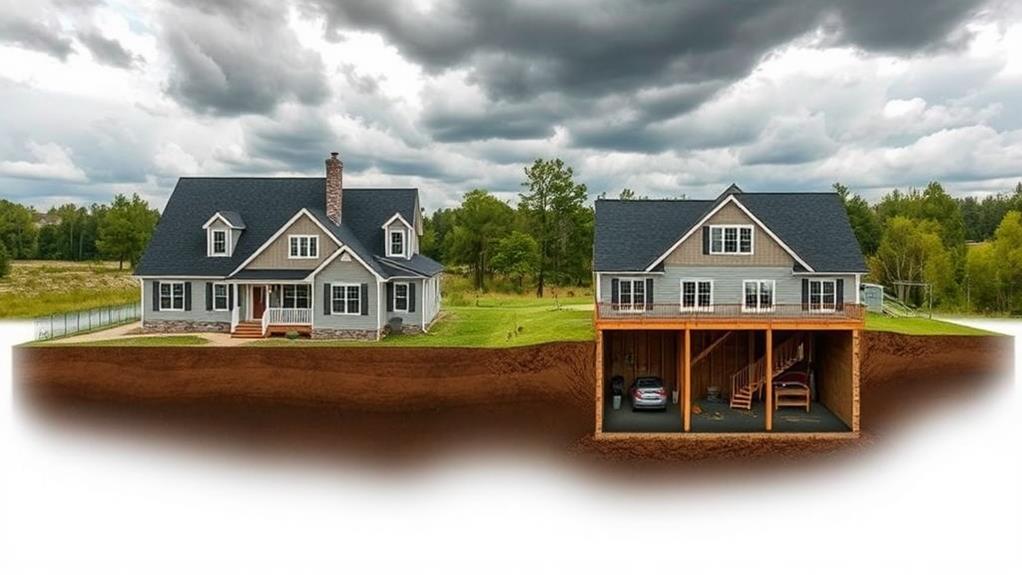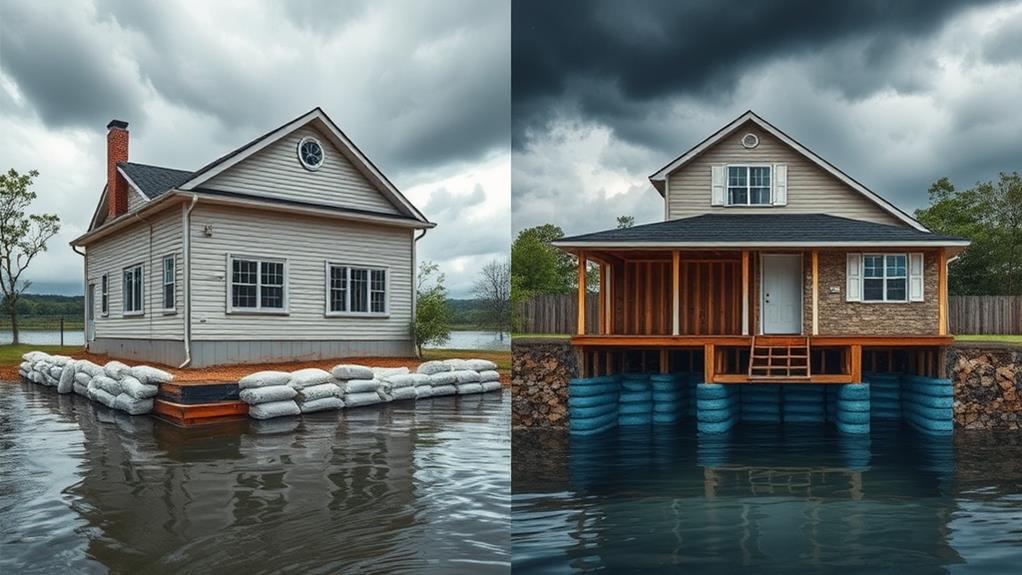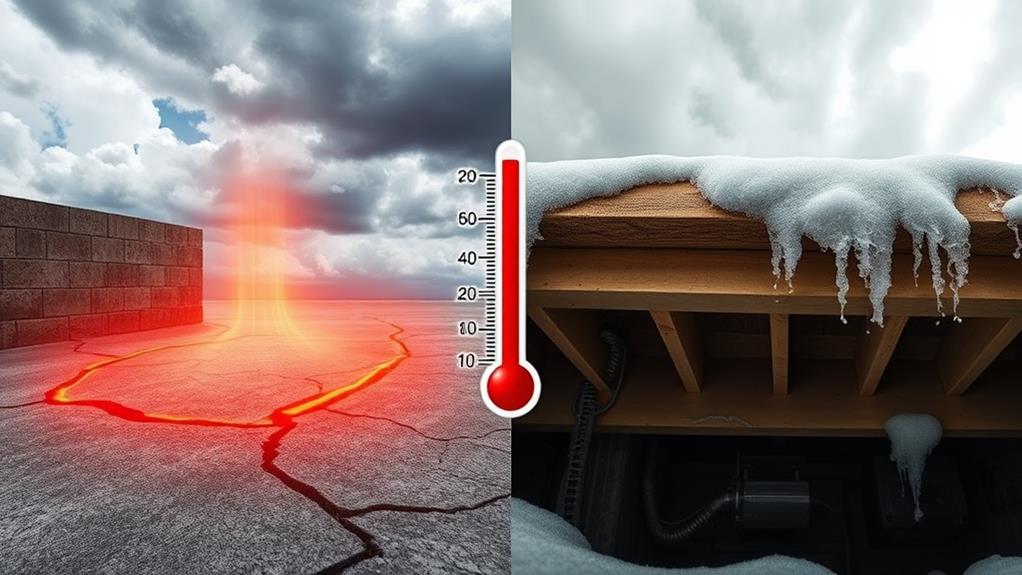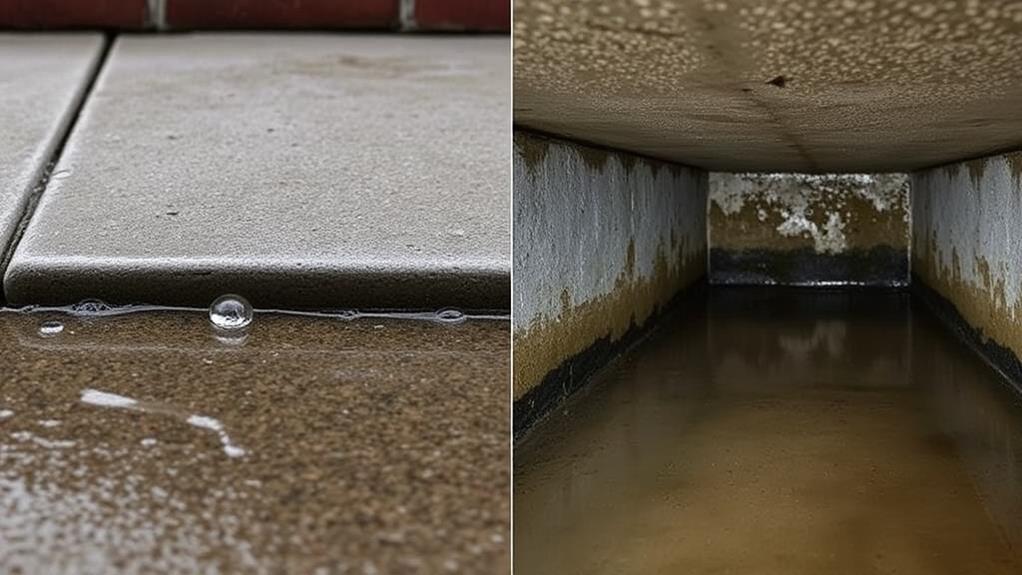The choice between slab and crawl space foundations in severe weather depends on specific risks and local conditions. Slab foundations generally offer better flood and wind resistance, while crawl spaces provide easier access for repairs and better protection against freezing. Both can be engineered for earthquake resilience. Slabs are less prone to moisture issues, but crawl spaces allow for simpler maintenance. Cost-effectiveness varies based on climate and soil type. Proper implementation of mitigation strategies is crucial for both foundation types. Ultimately, the best choice hinges on a thorough assessment of local weather patterns, soil conditions, and long-term maintenance considerations.
Understanding Slab Foundations

A slab foundation, often referred to as a concrete slab, is a type of foundation that consists of a single layer of concrete poured directly onto the ground. This foundation style is typically 4 to 6 inches thick and reinforced with steel rods or wire mesh to enhance its strength and durability. Slab foundations are common in areas with stable soil conditions and climates that don't experience frequent freezing temperatures.
One of the main advantages of slab foundations is their cost-effectiveness, as they require less material and labor compared to other foundation types. They also provide a solid, level surface for flooring and help insulate the home from ground moisture. In severe weather conditions, slab foundations can offer good resistance to high winds and flooding, as they have no crawl space for water to accumulate.
However, slab foundations do have some drawbacks. They can be prone to cracking in areas with expansive soils or seismic activity. Additionally, accessing plumbing and electrical systems can be more challenging, as these are typically embedded within the concrete. Despite these limitations, slab foundations remain a popular choice for many homeowners due to their simplicity and overall performance in various weather conditions.
Crawl Space Foundation Basics
Crawl space foundations, an alternative to slab foundations, elevate the main living area of a home above ground level. This type of foundation typically consists of short foundation walls on concrete footings, creating a space beneath the house that ranges from 3 to 4 feet in height. The floor of the crawl space is often bare earth or gravel, though it may be covered with a vapor barrier to control moisture.
One of the primary advantages of crawl space foundations is their accessibility for maintenance and repairs. Plumbing, electrical wiring, and HVAC systems can be easily accessed through the crawl space, simplifying inspections and repairs. Additionally, crawl spaces provide natural insulation and can help regulate indoor temperatures.
However, crawl spaces are susceptible to moisture-related issues, including mold growth and wood rot if not properly maintained. Proper ventilation and moisture control measures, such as vapor barriers and dehumidifiers, are crucial for preventing these problems. In areas prone to flooding, crawl spaces may require additional waterproofing measures to protect the home's structure and prevent water damage.
Flood Resistance Comparison

When comparing flood resistance between slab and crawl space foundations, several factors come into play. Slab foundations generally offer better protection against flooding due to their elevated design. The concrete slab is typically raised above ground level, creating a barrier against water infiltration. This design makes it more difficult for floodwaters to enter the living space, reducing the risk of water damage and mold growth.
Crawl space foundations, while more vulnerable to flooding, can be modified to improve their flood resistance. Installing proper drainage systems, sump pumps, and waterproofing measures can significantly enhance a crawl space's ability to withstand flood events. Additionally, elevating the house on piers or using flood vents can allow water to flow through the crawl space without causing extensive damage to the structure.
However, in severe flooding scenarios, crawl spaces may still be more susceptible to water intrusion and subsequent damage. The open nature of crawl spaces provides more entry points for water compared to the solid barrier of a slab foundation. Ultimately, the effectiveness of flood resistance depends on factors such as local flood risks, site topography, and the implementation of proper flood mitigation strategies.
Hurricane and Wind Performance
The performance of slab and crawl space foundations during hurricanes and high-wind events is a critical consideration for homeowners in storm-prone regions. Slab foundations generally offer superior resistance to wind uplift forces due to their solid, monolithic structure. The low profile and lack of underfloor space reduce the risk of wind penetration and pressurization, which can cause structural damage.
Crawl space foundations, while more vulnerable to wind-driven water intrusion, can provide some advantages in hurricane-prone areas. The elevated structure allows for easier post-storm inspections and repairs. Additionally, properly designed crawl spaces with adequate ventilation can help equalize pressure differences during storms, potentially reducing the risk of structural failure.
Both foundation types benefit from proper anchoring techniques. For slabs, this includes reinforced concrete and steel reinforcement bars. Crawl space foundations should utilize hurricane straps and bolts to secure the structure to the foundation. Regardless of the foundation type, adherence to local building codes and implementation of wind-resistant design features, such as impact-resistant windows and reinforced roof systems, are crucial for overall hurricane resilience.
Extreme Temperature Effects

Beyond wind and water resistance, the impact of extreme temperatures on foundation performance is a key consideration in severe weather regions. Both slab and crawl space foundations react differently to temperature extremes, affecting the overall stability and energy efficiency of a structure.
Slab foundations generally perform better in extreme heat due to their thermal mass. The concrete absorbs and slowly releases heat, helping to regulate indoor temperatures. However, in freezing conditions, slabs are more susceptible to frost heave, which can cause cracking and structural damage. Proper insulation and drainage are crucial to mitigate these risks.
Crawl spaces offer better protection against freezing temperatures, as the elevated floor creates a buffer zone between the ground and living space. This design also allows for easier access to plumbing and electrical systems during extreme weather events. However, crawl spaces are more vulnerable to heat buildup and humidity in hot climates, potentially leading to mold growth and reduced indoor air quality. Adequate ventilation and moisture control measures are essential to maintain the integrity of a crawl space foundation in severe weather conditions.
Earthquake Resilience
Earthquake resilience stands as a critical factor when comparing slab and crawl space foundations in seismically active regions. Slab foundations generally exhibit better performance during earthquakes due to their rigid, monolithic structure. This design distributes seismic forces more evenly across the entire foundation, reducing the risk of structural damage.
Crawl space foundations, while more flexible, can be vulnerable to lateral movement during seismic events. However, they offer advantages in terms of accessibility for post-earthquake inspections and repairs. Modern crawl space designs often incorporate seismic retrofitting techniques, such as anchor bolts and shear walls, to enhance their earthquake resistance.
Both foundation types can benefit from additional reinforcement measures. For slab foundations, this may include thicker concrete, more robust steel reinforcement, and improved soil preparation. Crawl spaces can be strengthened with cross-bracing, reinforced piers, and enhanced connections between the foundation and the structure above.
Ultimately, the choice between slab and crawl space foundations in earthquake-prone areas should consider local seismic conditions, soil types, and building codes. Professional engineering input is crucial to ensure optimal earthquake resilience for either foundation type.
Moisture and Mold Issues

While earthquake resilience is a key consideration, moisture and mold issues present another significant challenge when comparing slab and crawl space foundations in severe weather conditions. Slab foundations generally offer better protection against moisture intrusion, as they create a solid barrier between the ground and the living space. This design minimizes the risk of water seepage and subsequent mold growth, particularly during heavy rainfall or flooding events.
Crawl space foundations, on the other hand, are more susceptible to moisture-related problems. The open area beneath the house can accumulate moisture from the ground, leading to high humidity levels and potential mold growth. However, proper ventilation and moisture barriers can mitigate these risks. In severe weather, crawl spaces may be more vulnerable to flooding, but they also allow for easier inspection and remediation of water damage.
Both foundation types require proper drainage systems and regular maintenance to prevent moisture issues. Slab foundations benefit from effective grading and waterproofing, while crawl spaces need adequate ventilation, insulation, and vapor barriers. Ultimately, the choice between slab and crawl space foundations depends on local climate conditions, soil type, and the homeowner's willingness to invest in preventative measures against moisture and mold problems.
Repair and Maintenance Considerations
When considering repair and maintenance, slab and crawl space foundations present distinct challenges and advantages. Slab foundations generally require less maintenance due to their solid structure and lack of accessible space underneath. However, when repairs are necessary, they can be more complex and costly, often involving breaking through the concrete to access plumbing or electrical systems.
Crawl space foundations offer easier access for repairs and inspections, allowing homeowners to identify and address issues more quickly. Regular maintenance, such as checking for moisture, pests, and structural integrity, is essential for crawl spaces. This accessibility can lead to lower repair costs in the long run, as problems are often caught early.
In severe weather conditions, both foundation types may require additional maintenance. Slabs may need crack repairs or leveling if soil shifts occur, while crawl spaces might require reinforcement of support beams or treatment for water damage. Proper drainage systems and regular inspections are crucial for both types to prevent weather-related issues. Ultimately, the choice between slab and crawl space foundations should consider local climate, soil conditions, and the homeowner's willingness to perform regular maintenance.
Cost Analysis in Severe Weather

A comprehensive cost analysis of slab and crawl space foundations in severe weather conditions reveals significant differences in both initial construction and long-term expenses. Slab foundations generally have lower upfront costs due to simpler construction methods and fewer materials. However, in severe weather-prone areas, they may require additional reinforcement, increasing initial expenses.
Crawl space foundations typically have higher initial costs due to more complex construction and materials. Yet, they often prove more cost-effective in the long run, especially in regions prone to flooding or extreme weather. The elevated design reduces the risk of water damage, potentially saving homeowners significant repair costs over time.
In severe weather events, slab foundations may incur higher repair costs due to limited access to utilities and potential cracking. Crawl spaces offer easier access for repairs and modifications, potentially lowering long-term maintenance expenses. However, they may require additional waterproofing and insulation to prevent moisture-related issues, adding to ongoing costs.
Ultimately, the most cost-effective foundation choice depends on local climate conditions, soil type, and the frequency of severe weather events in the area.
Frequently Asked Questions
Can I Convert My Existing Foundation From Slab to Crawl Space or Vice Versa?
Converting an existing foundation from slab to crawl space or vice versa is technically possible but extremely complex and costly. It involves significant structural modifications and is rarely recommended unless absolutely necessary. Consult a professional structural engineer for a thorough assessment.
How Do Slab and Crawl Space Foundations Affect Home Insurance Premiums?
Like a financial tightrope, foundation type can sway insurance premiums. Crawl spaces often lead to higher costs due to increased moisture risks, while slabs generally result in lower premiums thanks to their reduced vulnerability to certain hazards.
Which Foundation Type Is Better for Areas Prone to Sinkholes?
For areas prone to sinkholes, crawl space foundations generally offer better protection. Their elevated structure allows for easier monitoring and detection of ground shifts, potentially providing early warning signs and reducing the risk of catastrophic structural damage.
Do Slab or Crawl Space Foundations Offer Better Protection Against Termites?
Crawl space foundations generally offer better protection against termites compared to slab foundations. The elevated structure allows for easier inspection, treatment, and prevention measures. However, proper moisture control and regular monitoring are essential for both foundation types to deter termite infestations.
How Do These Foundation Types Impact the Resale Value of a Home?
Foundation fundamentals significantly influence home value. Crawl spaces can command higher prices due to accessibility and potential for extra storage. Slabs, while less versatile, may appeal to buyers seeking low-maintenance options. Ultimately, local preferences and market trends determine resale impact.
Conclusion
In the battle against nature's fury, both slab and crawl space foundations stand as modern-day Davids against meteorological Goliaths. While each possesses unique strengths—the slab's monolithic resistance and the crawl space's adaptability—neither emerges as a clear Achilles' heel-free victor. The choice between these foundational titans ultimately hinges on a complex interplay of local climate, soil conditions, and homeowner priorities. Like the foundations of ancient temples, the ideal choice must withstand both the test of time and the tempests of tomorrow.

